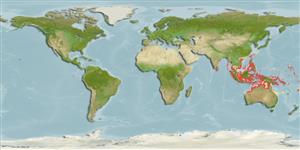>
Eupercaria/misc (Various families in series Eupercaria) >
Labridae (Wrasses)
Etymology: Paracheilinus: Greek, para = the side of + Greek, chaite = hair + Greek, odous = teeth (Ref. 45335).
Environment: milieu / climate zone / depth range / distribution range
البيئة
بحري مرتبطة بالشعاب; نطاق العمق 5 - 35 m (Ref. 9710), usually 10 - 25 m (Ref. 48636). Tropical; 24°C - 28°C (Ref. 27115)
Indo-Pacific: Similan Islands, Andaman Sea and Christmas Island in the eastern Indian Ocean; Kranket Islands, Madang, New Guinea; off Manado and Celebes (Indonesia); Concoro Islands, Cuyo Islands, Philippines, and the Solomon Islands (Ref. 2139). Ryukyu Islands, Taiwan, Palau, and the Great Barrier Reef (Ref. 9823).
الحجم / وزن / العمر
Maturity: Lm ? range ? - ? cm
Max length : 15.0 cm SL ذكر/ مختلط الجنس; (Ref. 9823)
الأشواك الظهرية (المجموع) : 9; الأشعة الظهرية الناعمة (المجموع) : 11; شوكة شرجية: 3; أشعه شرجية لينه: 9; فقرات: 25. Emarginate caudal fin become lunate in males; 2-6 soft dorsal rays of males greatly prolonged (the odd-numbered rays beginning with the first); may be slightly prolonged in females (not so in Philippine adult females); non filamentous rays approximately equal in length (Ref. 2139). Tubed peduncular scales 5.9; side of body with four or five narrow red to blue stripes, only the first and third extending full length of body (Ref. 41634).
This group may consist of several different species and genetic studies are required (Ref. 90102). Found in rubble areas in passages and outer reef slopes. Also occurs in lagoons. Feeds on zooplankton and other benthic invertebrates. Occurs in small to large groups of mix sexes but females outnumber males greatly. Some geographical variations of nuptial males that are influenced by the presence of similar species. Males readily display to each other or to females to spawn by flashing their colors and 'racing' past with erected fins. Hybridizes with several other species, and are most colorful where other similar species occur in the same area (Ref. 48636). At 15 cm SL, this could well be the largest species of the genus so far (CB).
Life cycle and mating behavior
النضج | التكاثر | وضع البيض | بيض | الخصوبة | Larvae
Oviparous, distinct pairing during breeding (Ref. 205).
Randall, J.E. and R. Lubbock, 1981. Labrid fishes of the genus Paracheilinus, with descriptions of three new species from the Philippines. Jap. J. Ichthyol. 28(1):19-30. (Ref. 2139)
IUCN Red List Status (Ref. 130435: Version 2024-1)
استخدامات بشرية
مصائد: غير ذات اهمية; حوض مائي: تجاري
أدوات
تقارير خاصة
Download XML
مصادر علي الأنترنت
Estimates based on models
Preferred temperature (Ref.
123201): 26.4 - 29, mean 28.2 °C (based on 398 cells).
Phylogenetic diversity index (Ref.
82804): PD
50 = 0.5000 [Uniqueness, from 0.5 = low to 2.0 = high].
Bayesian length-weight: a=0.00977 (0.00470 - 0.02030), b=3.07 (2.90 - 3.24), in cm total length, based on LWR estimates for this (Sub)family-body shape (Ref.
93245).
مستوى غذائي (Ref.
69278): 3.4 ±0.45 se; based on food items.
المرونه (Ref.
120179): عالي, الحد الزمني الأدني لتضاعف عدد أفراد المجتمع أقل من 15 شهر (Preliminary K or Fecundity.).
Fishing Vulnerability (Ref.
59153): Low vulnerability (10 of 100).
Nutrients (Ref.
124155): Calcium = 85.9 [50.1, 156.1] mg/100g; Iron = 0.807 [0.463, 1.541] mg/100g; Protein = 18.2 [15.3, 20.4] %; Omega3 = 0.153 [0.092, 0.254] g/100g; Selenium = 22.6 [13.1, 44.0] μg/100g; VitaminA = 240 [73, 866] μg/100g; Zinc = 1.65 [1.11, 2.60] mg/100g (wet weight);
